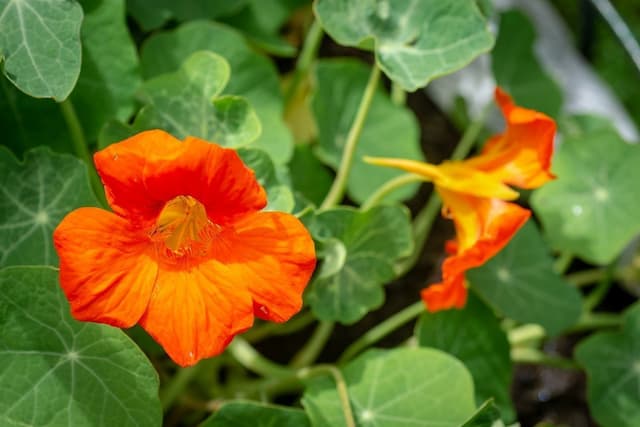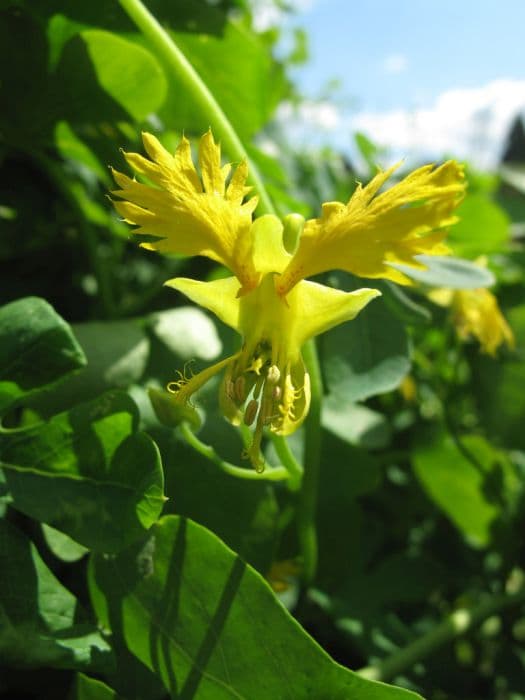Blue Nasturtium Tropaeolum azureum

ABOUT
Tropaeolum azureum, also known as blue nasturtium, boasts a captivating beauty with its unique floral and foliar characteristics. The plant is well-known for its stunning, vivid blue flowers that are a rare hue in the botanical world. The blossoms have a rounded shape, with five distinct petals that are softly ruffled at the edges, lending them an almost delicate appearance. The center of each flower is highlighted by a contrasting color, often with a darker blue or purplish hue, which draws the eye and adds visual depth to each blossom. Encircling the petals are slender, nectar-rich spurs that are attractive to pollinators. The foliage of the blue nasturtium is no less striking; the leaves are rounded and shield-shaped with a lush, green color that provides a perfect backdrop to showcase the spectacular flowers. The leaves are borne on long, slender stalks that emanate from the stem. The overall appearance of the blue nasturtium is one of grace and whimsy, as the vivid blooms contrast with the greenery, creating a cascading effect that is particularly aesthetic. This ornamental plant has an almost wild, yet sophisticated look, which makes it a favorite among gardeners seeking to add a splash of color and a touch of the unusual to their floral displays.
About this plant
 Names
NamesFamily
Tropaeolaceae
Synonyms
Blue Nasturtium, Azurean Nasturtium, Blue Tropaeolum
Common names
Tropaeolum azureum
 Toxicity
ToxicityTo humans
The common name for Tropaeolum azureum is Blue Nasturtium. It is not commonly known for being toxic to humans. There is little to no documented toxicity in the scientific literature concerning human ingestion of this particular plant. However, as with the ingestion of any plant material, individuals may experience varying reactions, and it is always best to exercise caution and seek expert advice before consuming plants that are not commonly used as food.
To pets
The common name for Tropaeolum azureum is Blue Nasturtium. Similar to its effects on humans, Blue Nasturtium is not widely recognized as a toxic plant to pets. There is limited information regarding its toxicity towards animals, and it appears to be generally safe. However, each animal may react differently, and caution is advisable. Pet owners should prevent their animals from consuming plants that are not part of their typical diet and consult with a veterinarian if any unusual behavior or symptoms arise after ingestion.
 Characteristics
CharacteristicsLife cycle
Perennials
Foliage type
Deciduous
Color of leaves
Green
Flower color
Blue
Height
6 feet (1.83 meters)
Spread
6 feet (1.83 meters)
Plant type
Climber
Hardiness zones
10
Native area
Chile
Benefits
 General Benefits
General Benefits- Decorative Appeal: Tropaeolum azureum, commonly known as blue nasturtium, adds vibrant color and visual interest to gardens with its striking blue flowers.
- Easy to Grow: Blue nasturtium is known for being easy to cultivate, making it a good choice for beginner gardeners or those wanting low-maintenance plants.
- Pest Repellent: The plant is often used in companion planting because it can help repel certain pests that might otherwise damage garden crops.
- Edible Parts: The leaves and flowers of blue nasturtium are edible, adding a peppery flavor to salads and serving as an attractive garnish.
- Attracts Pollinators: Blue nasturtium flowers attract beneficial pollinators like bees and butterflies, which are essential for a healthy and productive garden.
- Soil Improvement: As a cover crop, it can help suppress weeds and improve soil quality when used in crop rotation or as a ground cover.
 Medical Properties
Medical PropertiesThis plant is not used for medical purposes.
 Air-purifying Qualities
Air-purifying QualitiesThis plant is not specifically known for air purifying qualities.
 Other Uses
Other Uses- Tropaeolum azureum, commonly known as blue nasturtium, can be used as a natural food dye due to its vibrant blue flowers, offering a plant-based alternative to synthetic dyes.
- The leaves and flowers of the blue nasturtium are edible, adding a peppery flavor to salads and acting as a decorative, flavorful garnish for a variety of dishes.
- Due to its climbing nature, blue nasturtium can be used in vertical gardens, providing both aesthetic appeal and efficient use of space in small garden areas.
- The plant can serve as a trap crop, attracting pests away from more valuable plants in a garden and thus serving as a form of natural pest management.
- With its vibrant blue flowers, the blue nasturtium is popular for use in cut flower arrangements, providing a unique hue and exotic shape.
- Blue nasturtium seeds can be pickled and used as a substitute for capers, offering a homegrown alternative for culinary enthusiasts.
- The plant's fast-growing nature and dense foliage make it suitable for creating temporary green screens or privacy hedges in gardens and terraces.
- In companion planting, blue nasturtium can be placed near apple trees or vegetable gardens to deter specific pests like woolly aphids and improve crop yield.
- The use of blue nasturtium in educational settings for children's gardening projects can help instill an appreciation for plant life and an understanding of ecology due to its ease of growth and maintenance.
- As a natural source of nectar, the blue nasturtium attracts pollinators such as bees and butterflies, thus enhancing the biodiversity of the garden ecosystem.
Interesting Facts
 Feng Shui
Feng ShuiThe Blue Nasturtium is not used in Feng Shui practice.
 Zodiac Sign Compitability
Zodiac Sign CompitabilityThe Blue Nasturtium is not used in astrology practice.
 Plant Symbolism
Plant Symbolism- Vibrancy: The bright blue flowers of the Tropaeolum azureum, commonly known as Blue Nasturtium, symbolize a vibrant spirit and lively energy, reflecting its vivid and eye-catching blooms.
- Victory: Nasturtiums in general are associated with conquest and victory in battle, harking back to their name which means "trophy" in Latin, and Blue Nasturtium can carry this symbolism as well.
- Resilience: Blue Nasturtium can symbolize resilience and the ability to thrive in challenging conditions, as the plant is known to grow well even in poor soils.
- Optimism: With its sky-blue color, the Blue Nasturtium represents optimism and the hope of new opportunities, mirroring the open sky.
- Courage: The bold hue of the Blue Nasturtium can represent courage and the strength to face the unknown, much like the explorers who first encountered these plants in South America.
 Water
WaterThe Kenilworth Ivy should be watered moderately, allowing the soil to dry out slightly between waterings. A good approach is to provide about 1 gallon of water every week during the growing season, adjusting depending on weather conditions—less during rainy periods and more during dry spells. During winter, reduce watering to every other week or less, based on the plant's needs and the indoor temperature. Overwatering can be detrimental, so ensure proper drainage and avoid letting the plant sit in water.
 Light
LightKenilworth Ivy thrives in bright, indirect sunlight but can tolerate partial shade. It is best to place it in a spot with dappled sunlight or in an area that receives morning sunlight and afternoon shade to avoid scorching the leaves. East or north-facing windows are ideal locations for this plant.
 Temperature
TemperatureKenilworth Ivy prefers a temperature range between 50 and 72 degrees Fahrenheit. It can survive minimum temperatures down to around 45 degrees Fahrenheit for short periods, but it should not be exposed to frost. Ideal growing conditions involve maintaining a consistent temperature and avoiding sudden temperature changes.
 Pruning
PruningKenilworth Ivy benefits from periodic pruning to encourage bushier growth and maintain its shape. Prune in early spring before new growth starts, cutting back leggy stems to promote fuller plant development. Pruning can also be done after flowering to revitalize the plant and remove any spent blooms or dead foliage.
 Cleaning
CleaningAs needed
 Soil
SoilThe Blue Nasturtium prefers a well-draining soil mix with some added compost to feed its fast growth; aim for a pH between 6.0 and 7.5.
 Repotting
RepottingBlue Nasturtium benefits from repotting every 1 to 2 years to refresh the soil and accommodate its growth.
 Humidity & Misting
Humidity & MistingBlue Nasturtium thrives at moderate humidity levels, around 40-60%.
 Suitable locations
Suitable locationsIndoor
Place in bright, indirect light and keep soil lightly moist.
Outdoor
Full sun to part shade, shelter from strong winds, moist soil.
Hardiness zone
10-11 USDA
 Life cycle
Life cycleTropaeolum azureum, commonly known as Blue Nasturtium, begins its life cycle when its seeds germinate, usually in a warm, moist soil in early spring. The seedlings emerge and develop into a climbing vine with broad leaves, utilizing nearby structures or plants for support. As it matures, the plant produces distinctive bright blue flowers during the summer months, which are pollinated by insects. After pollination, the flowers develop into fruit capsules containing seeds. These seeds are dispersed by various means, such as by falling to the ground or being eaten and excreted by birds. As the growing season ends, Blue Nasturtium is an annual plant that completes its life cycle within one year and relies on the germination of its seeds to propagate the next generation.
 Propogation
PropogationPropogation time
Spring-early summer
Tropaeolum azureum, commonly known as Blue Nasturtium, is best propagated through seed sowing. The optimal time for sowing the seeds is in the spring after the last frost when the soil has warmed up to facilitate germination. To propagate Blue Nasturtium by seed, you should first soak the seeds in warm water for about 12 to 24 hours to soften the hard outer coat, enhancing germination rates. After soaking, sow the seeds about 1/2 inch deep (1.27 centimeters) directly into well-draining soil where you intend for the plant to grow, as they do not transplant well due to their sensitive taproots. Ensure the soil remains moist but not waterlogged throughout the germination period. Seedlings usually emerge in 10 to 14 days when the soil temperature is around 55-65 degrees Fahrenheit (about 13-18 degrees Celsius). After emergence, thin the seedlings to avoid crowding and ensure optimal growth conditions.




